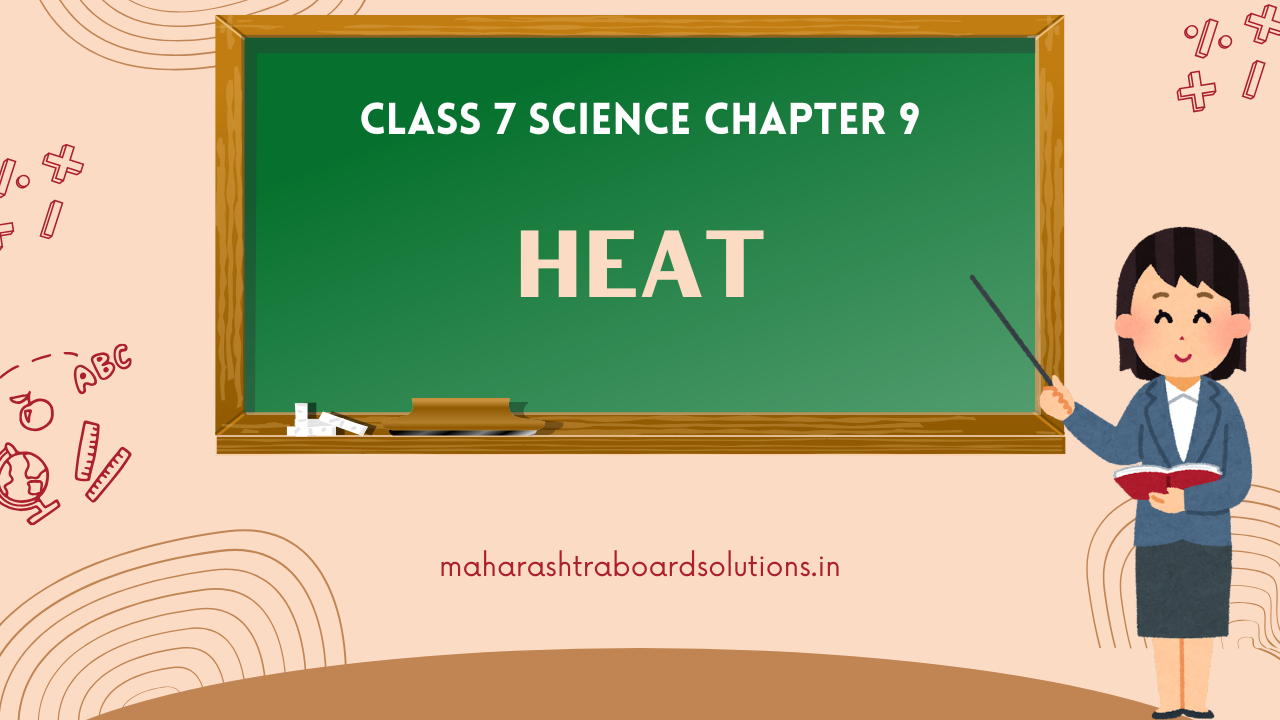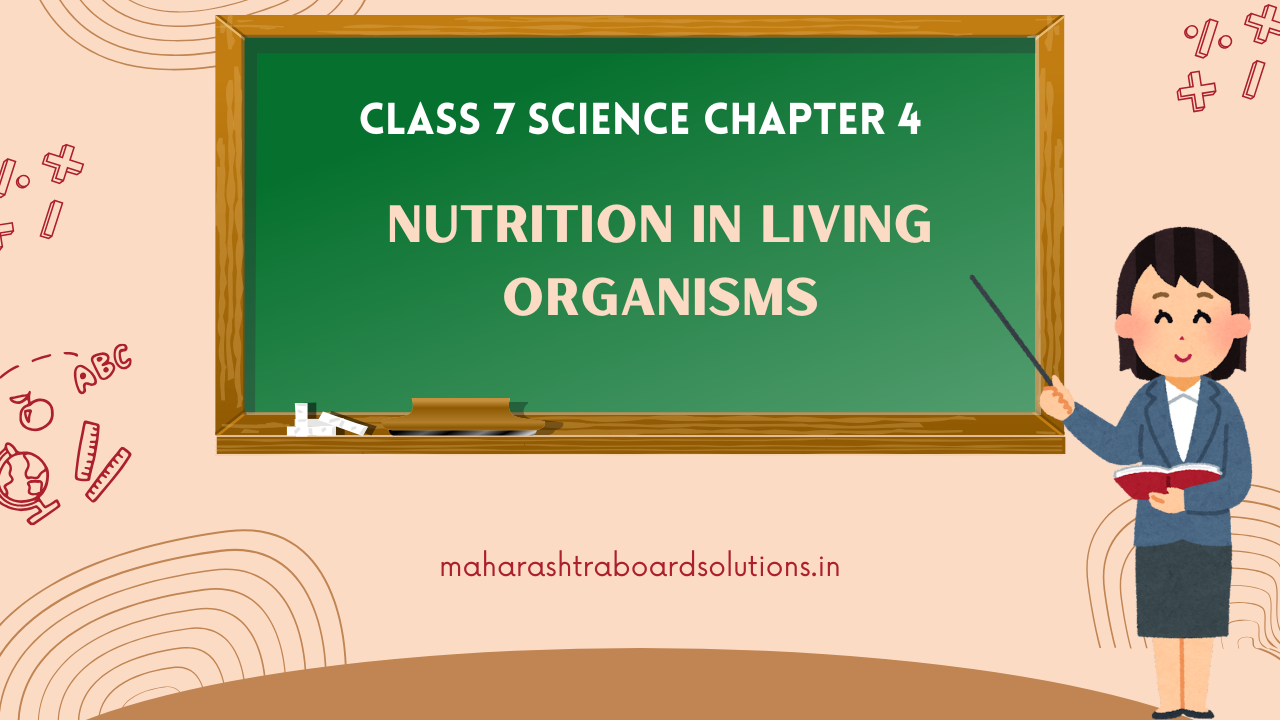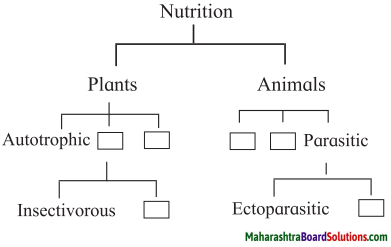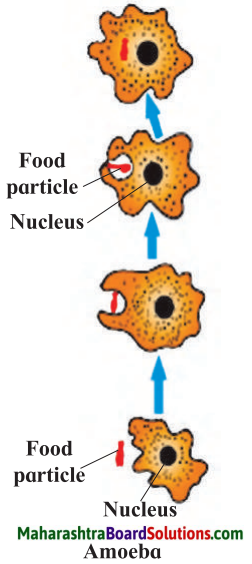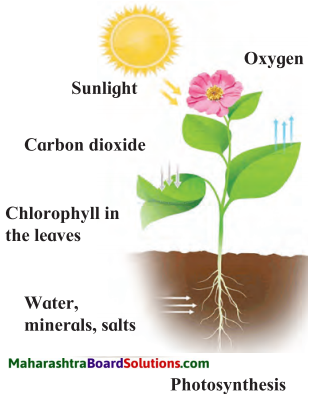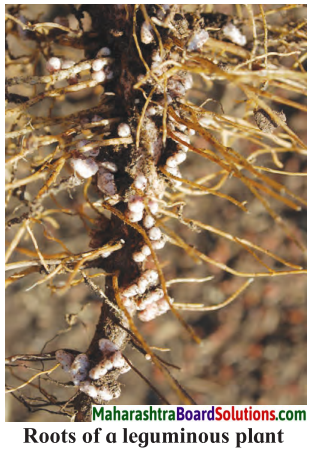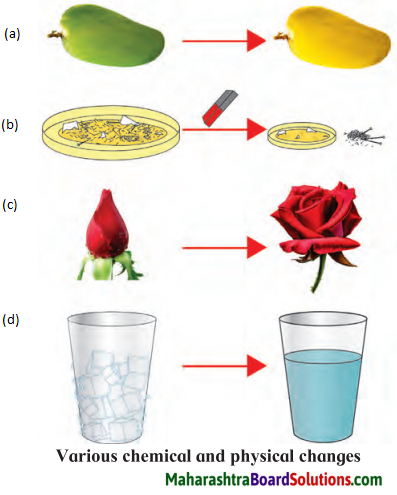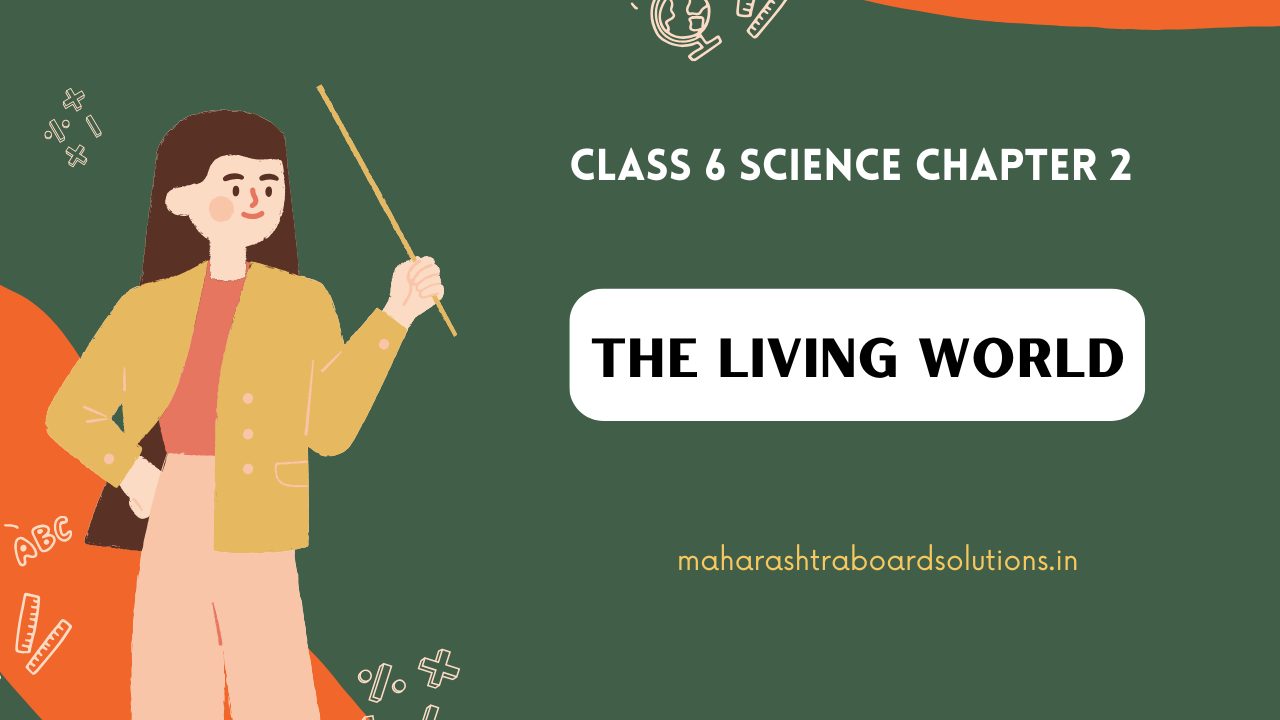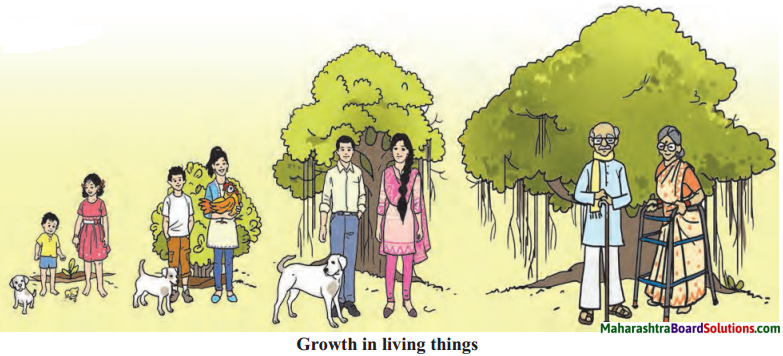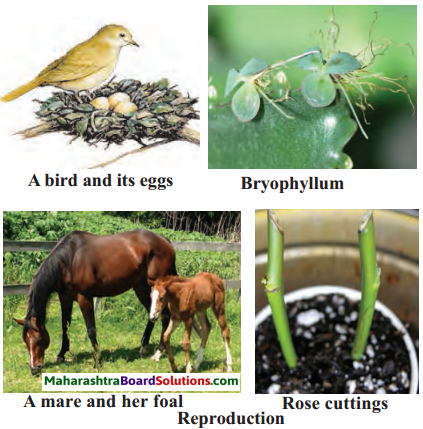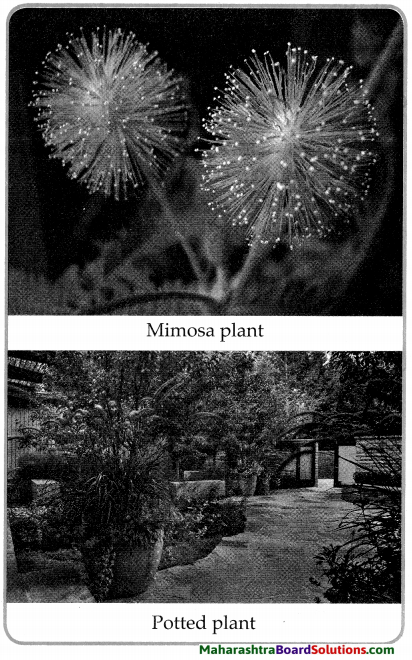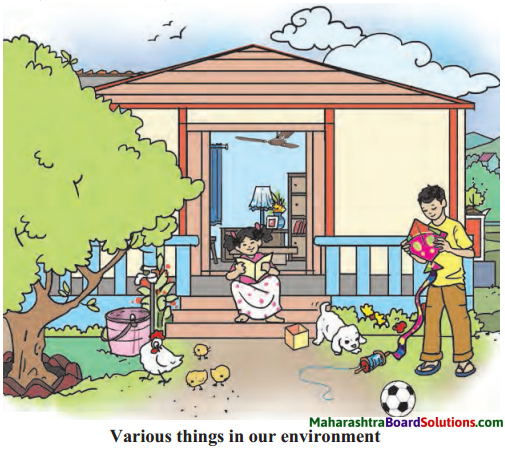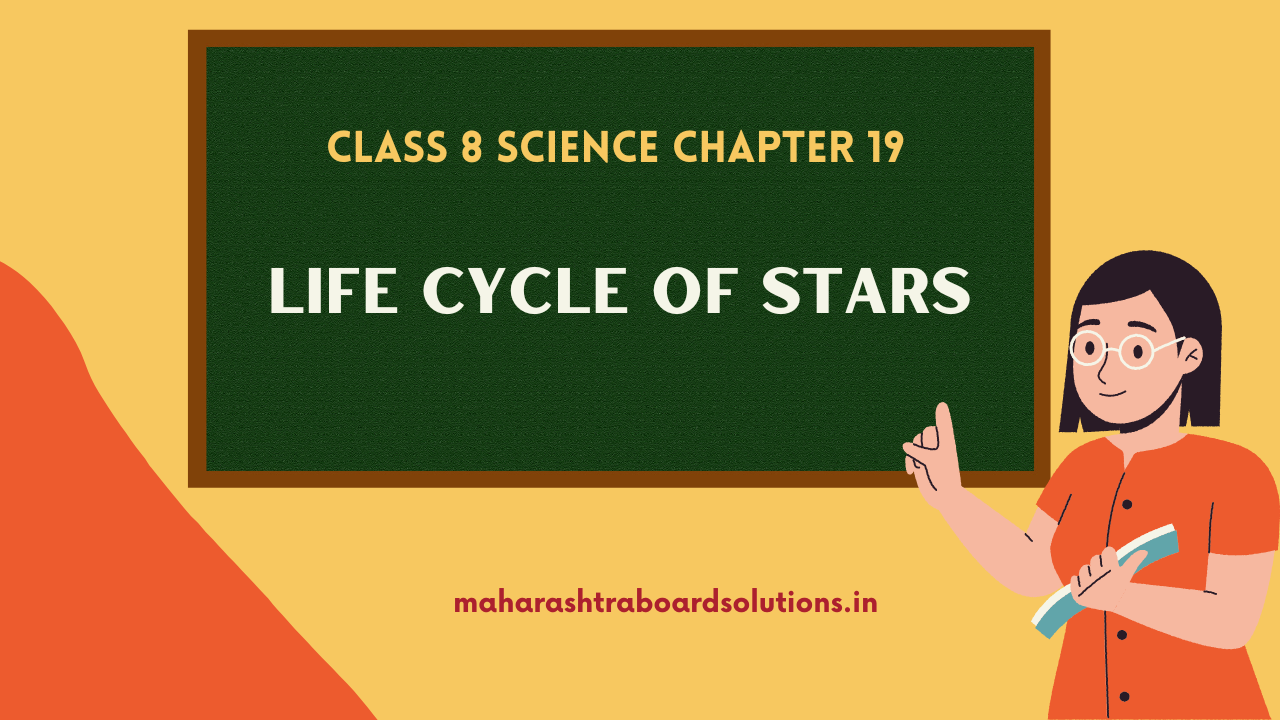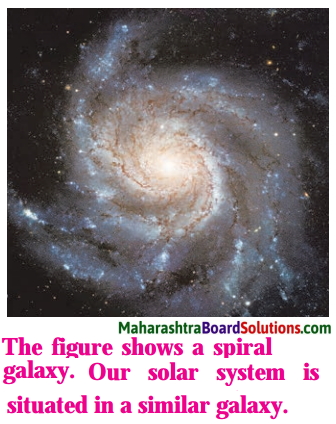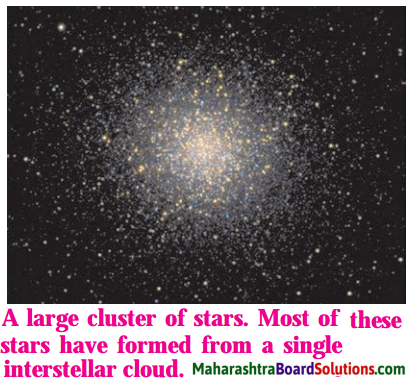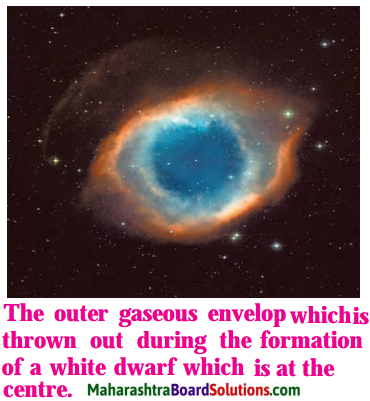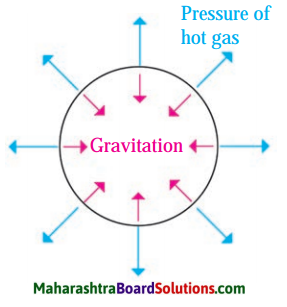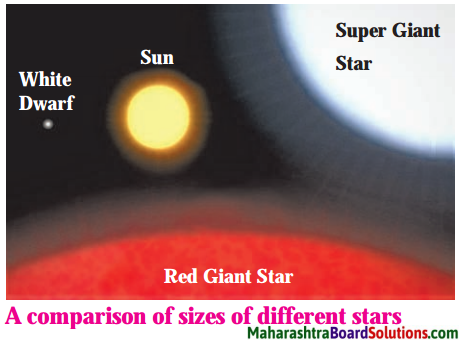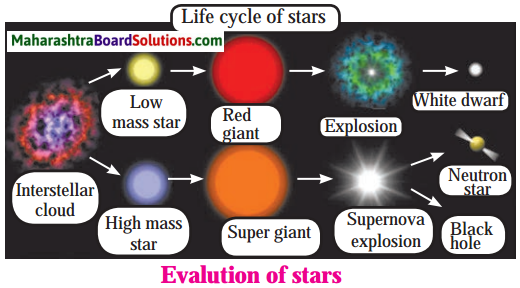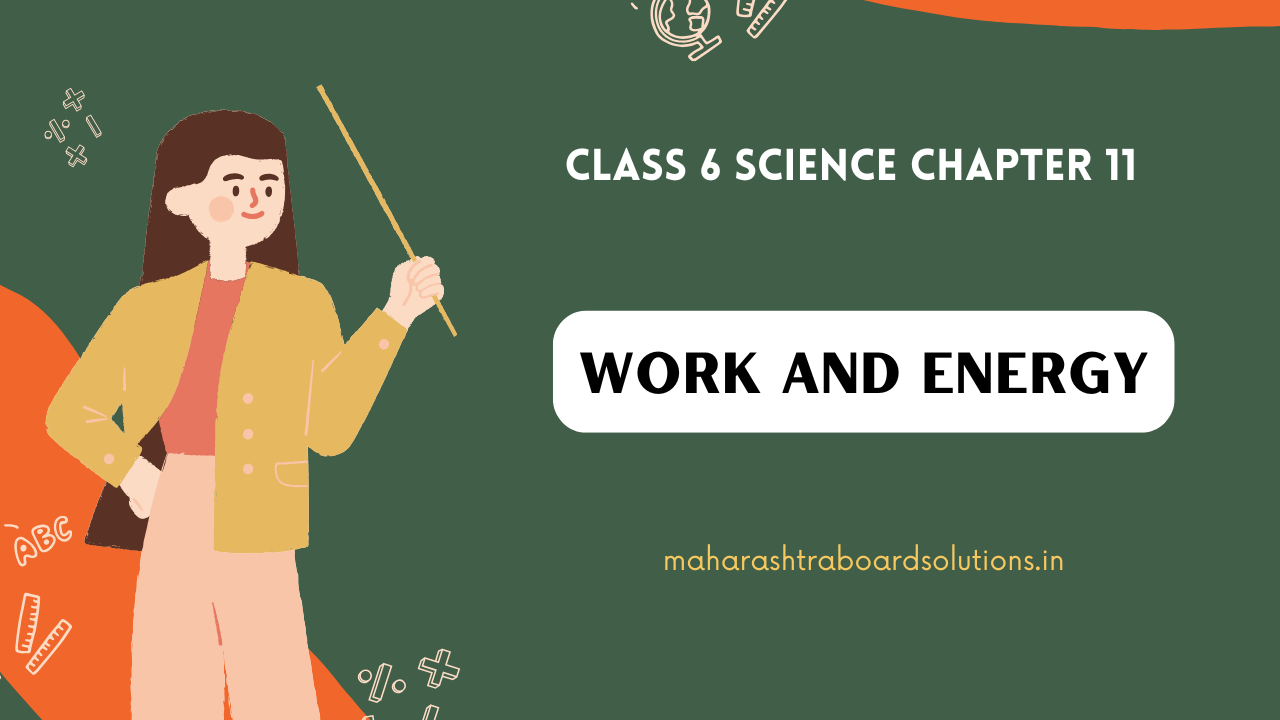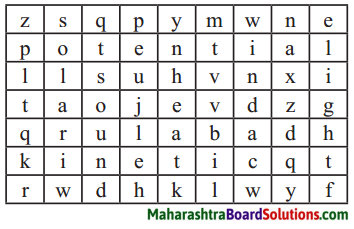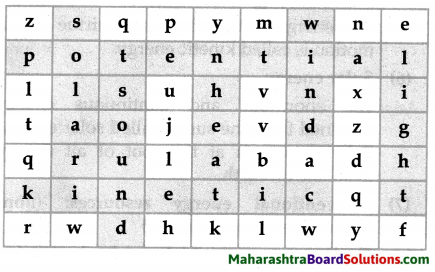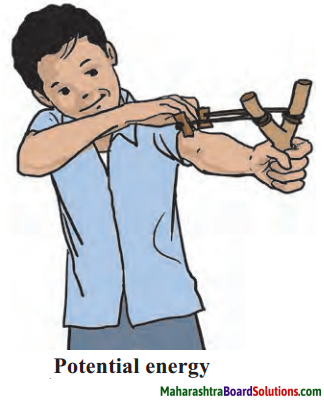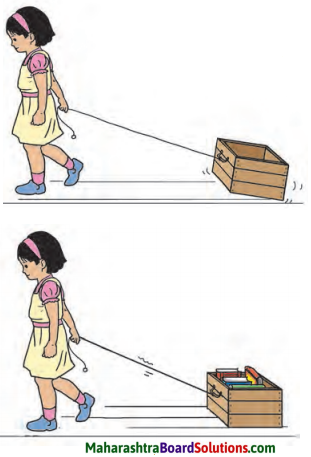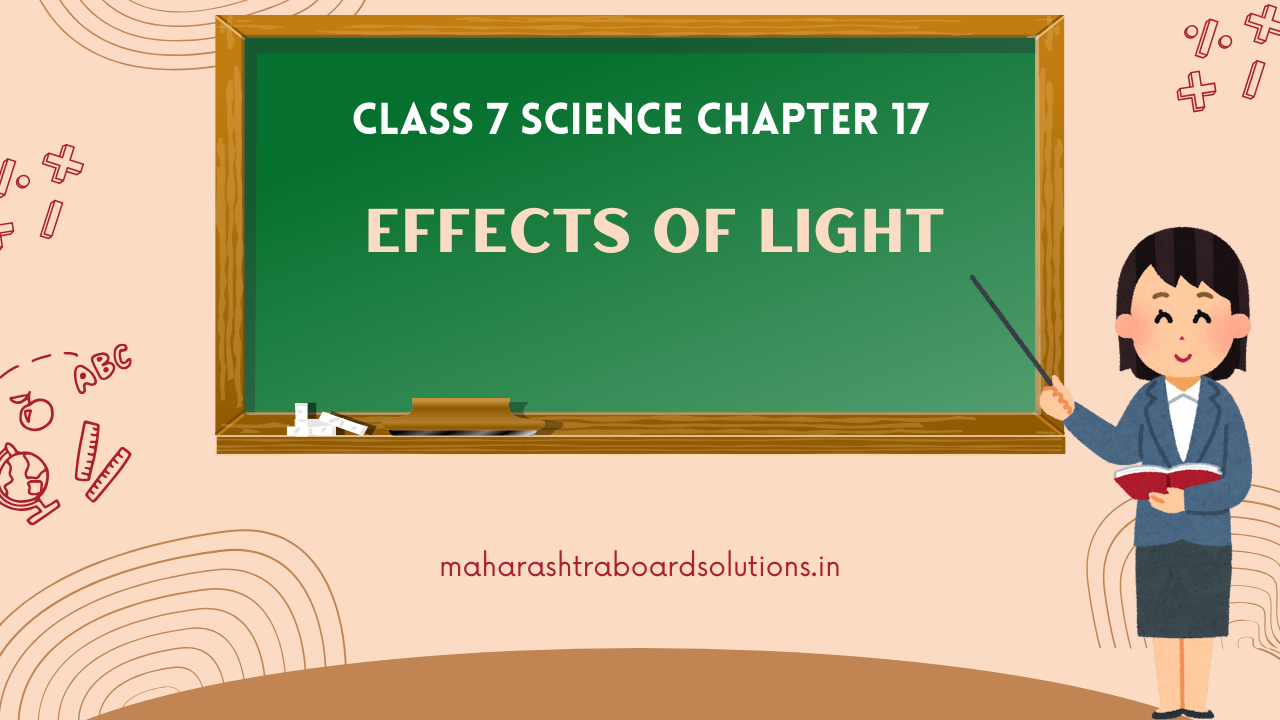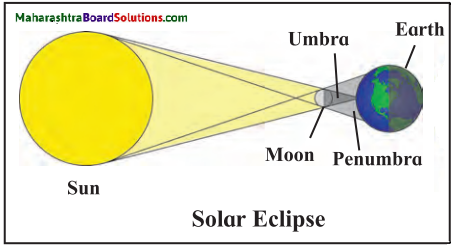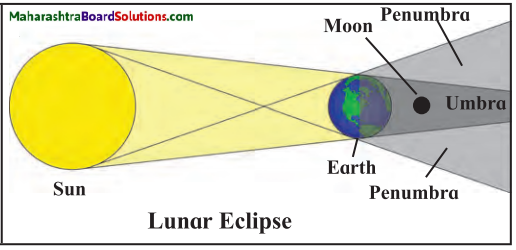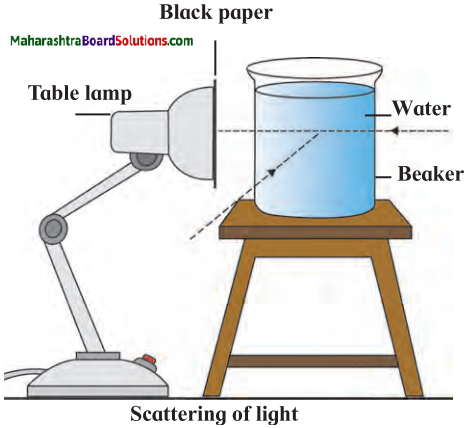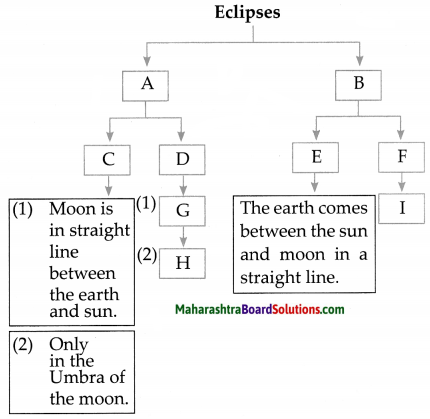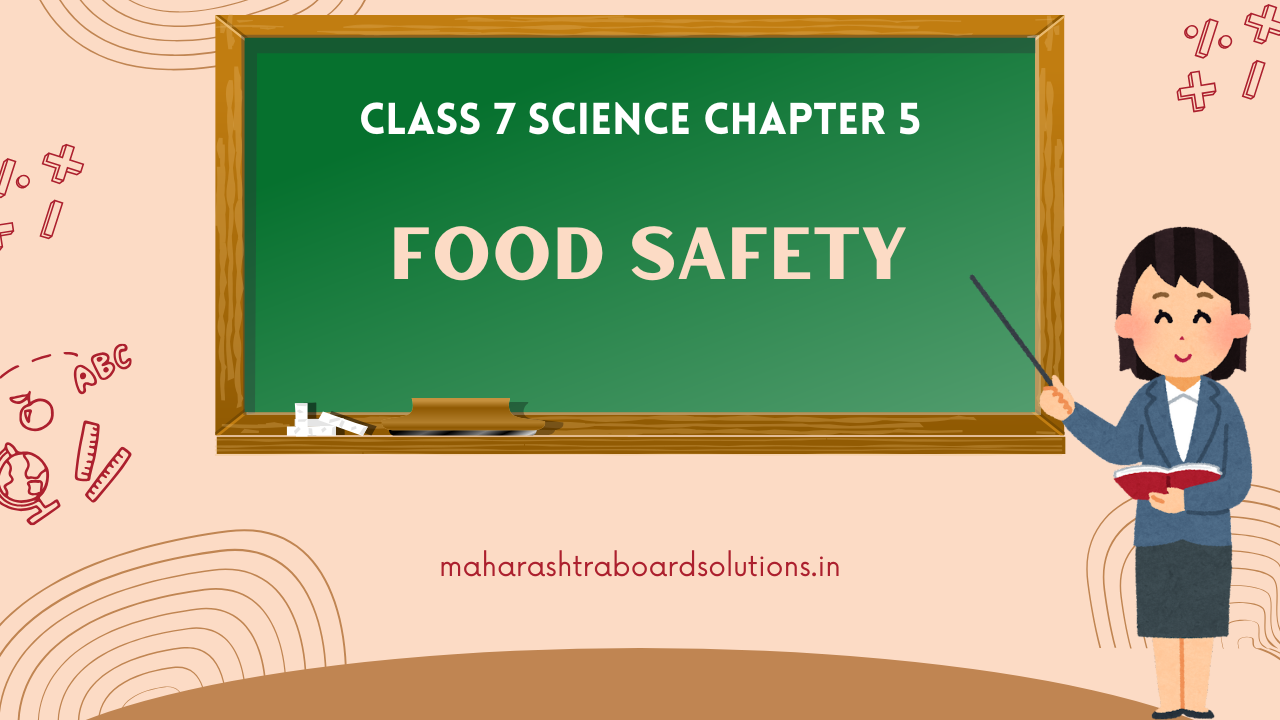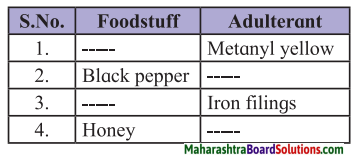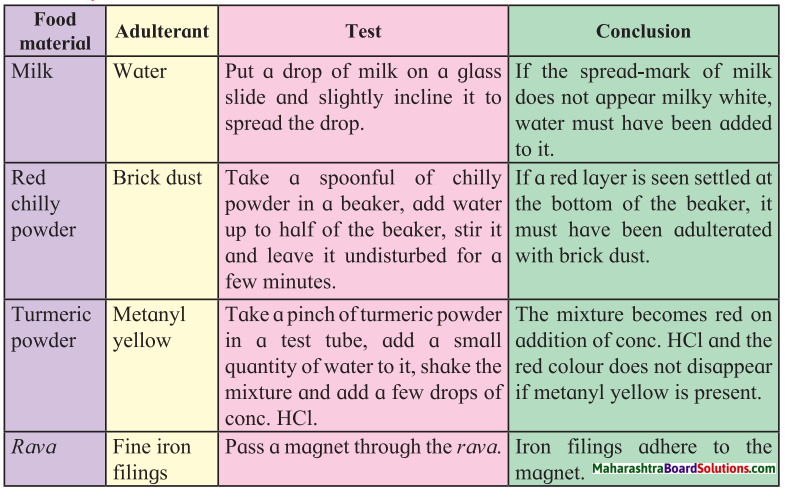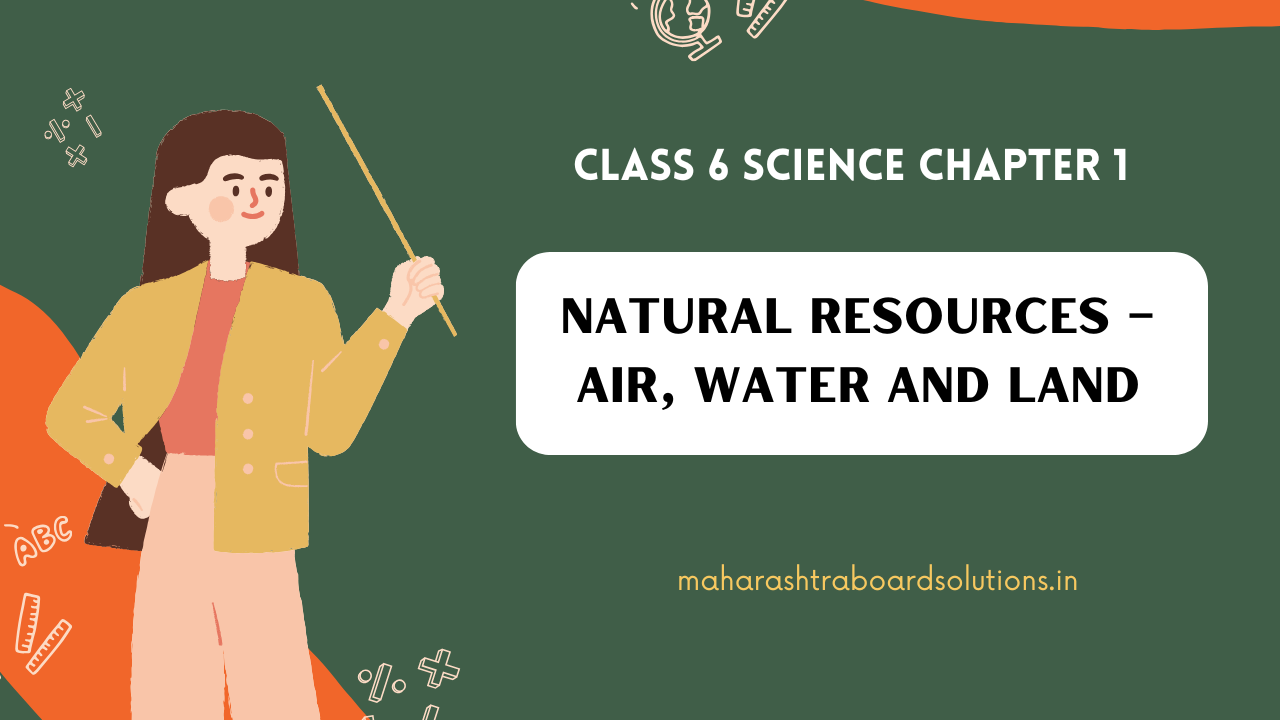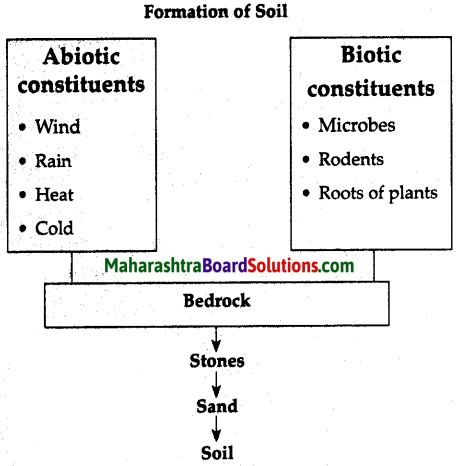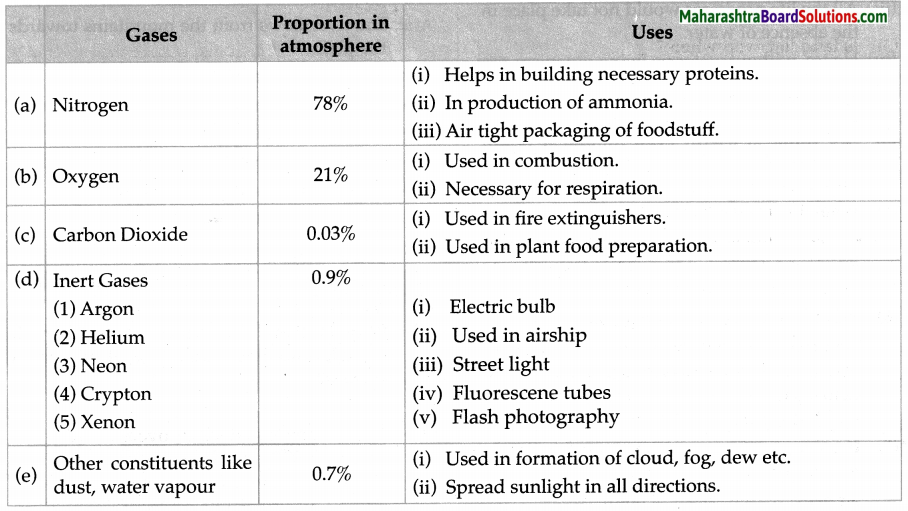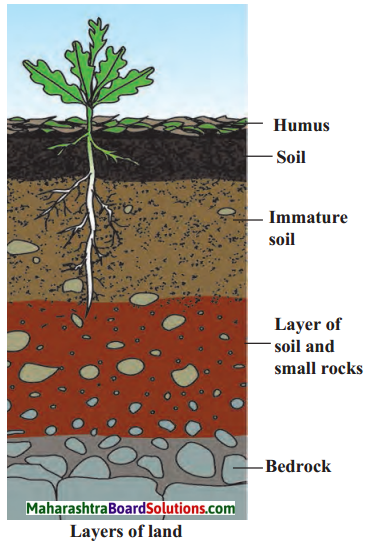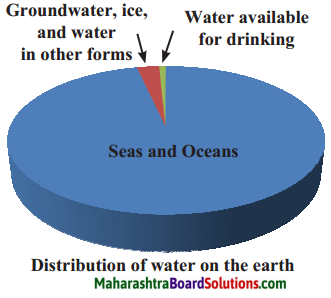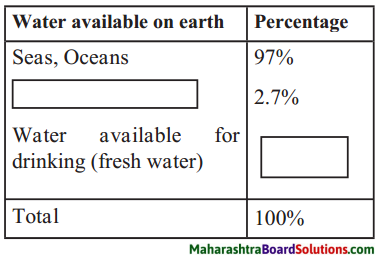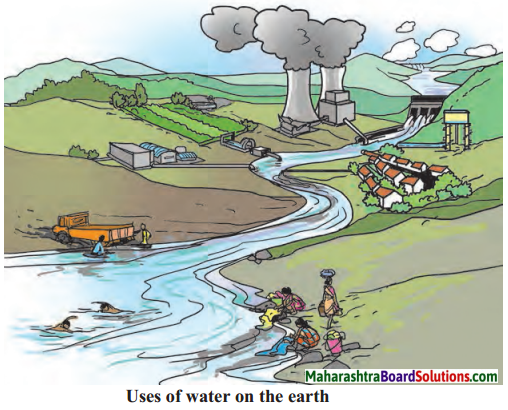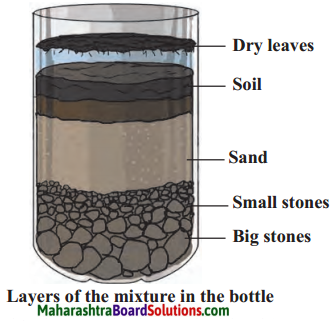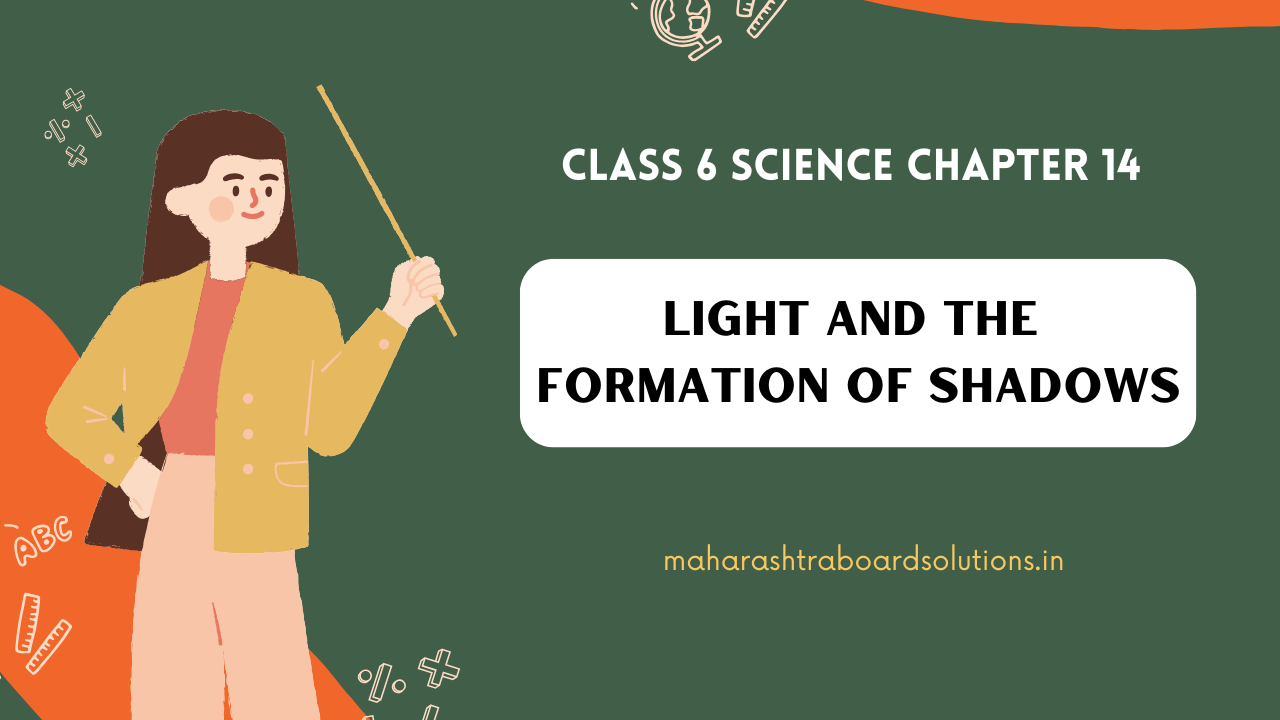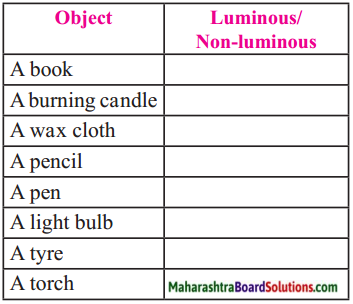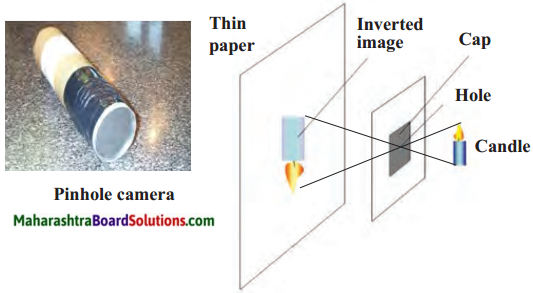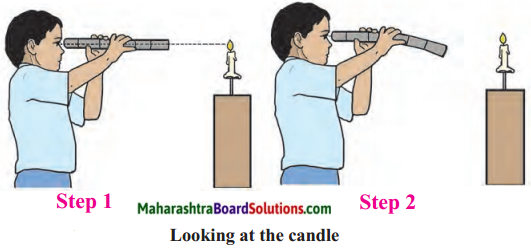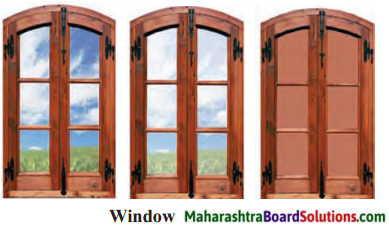Balbharti Maharashtra State Board Class 7 Science Solutions Chapter 9 Heat Notes, Textbook Exercise Important Questions and Answers.
Std 7 Science Chapter 9 Heat Question Answer Maharashtra Board
Class 7 Science Chapter 9 Heat Question Answer Maharashtra Board
Fill in the blanks:
Question a.
Maximum heat is absorbed by a ………….. coloured object.
Answer:
black
Question b.
……………. of heat does not require a medium.
Answer:
Radiation
![]()
Question c.
Conduction of heat takes place through a ……………. substance.
Answer:
solid
Question d.
The shining surface in a thermos flask decreases the outgoing heat by ……………… .
Answer:
reflection
Question e.
Cooking utensils are made from metals due to their property of ……………… .
Answer:
conduction
Question f.
The earth receives heat from the sun by ………………. .
Answer:
radiation
![]()
2. What will absorb heat?
Steel spoon, wooden board, glass vessel, iron griddle (lava), glass, wooden spoon, plastic plate, soil, water, wax.
Question a.
What will absorb heat?
Steel spoon, wooden board, glass vessel, iron griddle (lava), glass, wooden spoon, plastic plate, soil, water, wax.
Answer:
Following will absorb heat fast: steel spoon, iron griddle, water, wax. Remaining objects also obsorb heat but very slowly.
3. Write Answers to the following questions.
Question a.
How does a fever get lowered by putting a cold compress on the forehead of a patient?
Answer:
The water in the cold compress will evaporate by the heat of fever thus taking some local heat of the body and temperature of the body is lowered, therefore the fever gets lowered by putting a cold compress on the forehead of a patient.
Question b.
Why are the houses in Rajasthan painted white?
Answer:
Rajasthan being a desert, temperature is very high. So there is excess heat. White colour doesn’t absorb the heat but reflects back, so houses will not become hot due to excess heat and inside of the house will be cool. So the houses in Rajasthan are painted white.
![]()
Question c.
What are the modes of heat transfer?
Answer:
There are three modes of heat transfer:
- conduction
- convection
- radiation.
Question d.
Explain which mode of heat transfer causes sea breezes and land breezes?
Answer:
- Unequal heating of air above the sea and land sets up convection currents which cause sea breezes during the day time.
- The land near the sea is heated by sunlight to a higher temperature than the sea.
- As the air above the land is heated, it becomes lighter and moves upwards, its place is then taken by cooler air moving from the sea towards the land.
- Sea breezes are thus set up. At night, the land cools faster than water in the sea. Therefore air above sea water is hotter than air above the land.
- So cooler air from the land moves towards the sea forming land breeze.
Question e.
Why is the outer coat of the penguins of Antarctica black?
Answer:
The outer coat of the penguins of Antarctica is black because black colour absorbs heat so penguins get lots of heat due to this black colour and they can live easily in very, very cold Antarctica region.
![]()
Question f.
Why are heaters fitted near the floor and air conditioners near the ceiling of a room?
Answer:
1. Due to air conditioners, air becomes cool so its density increases and it becomes heavy. So it goes down and warm air with less density comes up and take the place of cold air. This cycle goes on and on and the whole room becomes cool.
2. If it is fitted near the floor then cool air of high density can’t go up and upper air with low density cannot come down and cooling of the room does not take place properly so air conditioners are fitted near the ceiling of a room.
3. Heaters are fitted near the floor. Due to heating, air becomes hot which is lighter than cold air. So it goes up and upper air with high density comes down.
4. This cycle goes on and on and the full room becomes warm. So heaters are fitted near the floor.
4. Give scientific reasons.
Question a.
An ordinary glass bottle cracks when boiling water is poured into it, but a borosil glass bottle does not.
Answer:
- An ordinary glass bottle cracks when we pour boiling water into it because there is a lot of temperature difference between the inner and outer parts of the glass.
- The inner part gets hot and expands while the outer part remains cold since glass is a bad conductor of heat.
- This unequal expansion causes the crack of glass bottle.
- But the borosil glass bottle has a very high melting point so the temperature difference is very less, hence it doesn’t crack.
![]()
Question b.
The telephone wires which sag in summer become straight in winter.
Answer:
- Telephone wires are made up of copper metal. Metals expand on heating.
- In summer the copper wire expands, thus the length of the wire increases between the two poles and instead of remaining straight it sags.
- In winter due to cold, it contracts and comes back to the original position, so it becomes straight in winter.
Question c.
Dewdrops form on the grass in winter.
Answer:
- During the winter, the temperature of air is low, its capacity to hold the vapour is less.
- At such times the excess water vapour is transformed into water droplets due to cold. And so the dew drops form on the grass in winter.
Question d.
In winter, why does an iron pillar feel colder than a wooden pole.
Answer:
- Iron is a metal and metals are very good conductors of heat so it transfers heat at a much faster rate than wood.
- That means, when we touch them, metals conducts away energy in the form of heat emitted by our hand and temperature of our hand lowers down and we get a cold’ sensation.
- This is what makes the metal appear colder than the wood.
- The wood is taking away heat at a much slower rate.
![]()
Project:
Question 1.
Make a note of the various examples of heat transfer seen in day-to-day life.
Class 7 Science Chapter 9 Heat Important Questions and Answers
Fill in the blanks:
Question 1.
………………… is an indicator of the heat in a substance.
Answer:
Temperature
Question 2.
………………. flows from higher temperature to lower temperature.
Answer:
Heat
![]()
Question 3.
Transfer of heat from one place to another takes place by ……………. or ……………. .
Answer:
conduction, convection, radiation
Question 4.
During conduction, particles of the substance …………….. in their place.
Answer:
vibrate
Question 5.
In a convection current, warm air travels …………….. .
Answer:
upwards
Question 6.
A …………….. is necessary for the conduction of heat.
Answer:
medium
![]()
Question 7.
The ………………. of conduction of heat through a medium depends on the medium.
Answer:
speed
Question 8.
Convection takes place only in …………… medium.
Answer:
fluid
Question 9.
Transfer of heat in the absence of a medium is called ……………… .
Answer:
radiation
![]()
Question 10.
Substances through which heat travels easily and quickly are called …………… .
Answer:
good conductors
Question 11.
Substances through which heat travels very slowly are called ………… of heat.
Answer:
bad conductors
Question 12.
Copper is a better ………… of heat than …………. .
Answer:
conductor, iron
![]()
Question 13.
………………. made first thermos flask in 1892.
Answer:
Sir James Dewar
Question 14.
Neither conduction nor convection of the heat occurs in thermos flask due to the ……………… .
Answer:
vacuum.
Match the following:
Question 1.
| Column ‘A’ | Column ‘B’ |
| 1. Good conductor | a. flow of particles |
| 2. Bad conductor | b. particles vibrate |
| 3. Conduction | c. glass |
| 4. Convection | d. copper |
Answer:
| Column ‘A’ | Column ‘B’ |
| 1. Good conductor | d. copper |
| 2. Bad conductor | c. glass |
| 3. Conduction | b. particles vibrate |
| 4. Convection | a. flow of particles |
![]()
Question 2.
| Column ‘A’ | Column ‘B’ |
| 1. Radiation | a. convection current |
| 2. Black body | b. conduction |
| 3. Vibration | c. absorbs more heat |
| 4. A rotating paper lantern | d. no medium |
Answer:
| Column ‘A’ | Column ‘B’ |
| 1. Radiation | d. no medium |
| 2. Black body | c. absorbs more heat |
| 3. Vibration | b. conduction |
| 4. A rotating paper lantern | a. convection current |
![]()
Say whether true or false, correct and rewrite the false statements:
Question 1.
Glass is a bad conductor of heat.
Answer:
True
Question 2.
In a thermos flask, hot things remain hot and cold things become warm.
Answer:
False. In a thermos flask, hot things remain hot and cold things remain cold.
Question 3.
Radiation of heat depends upon the colours of the outer surface of the body.
Answer:
True
![]()
Question 4.
During radiation, the particles of the medium vibrate.
Answer:
True
Question 5.
Copper is better conductor of heat than iron.
Answer:
True
Question 6.
During conduction, particles of the conductor leave their original place.
Answer:
False. During conduction, particles of the conductor do not leave their original place, but only vibrate in their own place.
Question 7.
Hot water is heavier than cold water.
Answer:
False – Hot water is lighter than cold water.
![]()
Question 8.
A convection current always travels down wards.
Answer:
False – A convection current always travels upwards.
Question 9.
Every warm substance continuously emits heat in all directions around itself.
Answer:
True
Question 10.
Air is a bad conductor of heat.
Answer:
True
Define the following:
- Conduction
- convection
- radiation
- Transfer of heat.
Answer:
- Conduction: The transfer of heat from one end of a solid substance to the other, without the particles leaving their original place is called conduction.
- Convection: Transfer of heat in fluids due to formation of currents is called convection.
- Radiation: Transfer of heat in all directions in the absence of a medium is called radiation.
- Transfer of heat: The flow of heat from one place to another is called transfer of heat.
![]()
Give scientific reasons:
Question 1.
Cricketers wear white clothes when playing in the sun.
Answer:
White clothes do not absorb heat but reflect back therefore cricketers wear white clothes while playing in the sun.
Question 2.
Sawdust is a bad conductor of heat.
Answer:
Sawdust is a bad conductor of heat because heat travels very slowly through it.
Question 3.
We can feel the heat of table lamp under it.
Answer:
We can feel the heat of table lamp under it because every warm substance continuously emits heat in all directions around itself by radiation.
![]()
Question 4.
Medium is necessary for conduction.
Answer:
Conduction is the transfer of heat from one end of a substance to another. Transfer of heat has to be done by particles of a substance and particles of a substance are particles of a medium. Hence, a medium is necessary for conduction.
Question 5.
Explain the structure and functioning of thermometer containers-
Answer:
- Thermoware containers keep food hot. These containers consist two boxes fitted one inside the other.
- The outer box is made up of plastic while the inner one is made up of a shiny metal, there is air between the two boxes.
- Air is a bad conductor of heat. Thus, heat is not lost by either conduction or convection. Also, the shiny inner surface prevents heat loss due to radiation.
- The container has a plastic lid. This also prevents any transfer of heat.
Question 6.
what is mailed infrared camera? Write its uses.
Answer:
- Radiation of heat takes place from many objects in nature such as trees, mountains, stones and roads.
- A camera has been developed which uses these radiations to make our surroundings visible even at night. This is called infrared camera.
- It is used to keep watch on the movements of the enemy during the night.
- It is also used to track the movements of animals in the wild.
![]()
Question 7.
Why is mercury used in a thermometer?
Answer:
Mercury is used in a thermometer because of the following properties.
- There is a big difference between the freezing point and boiling point of mercury. Its freezing point is – 39° C and its boiling point is 357° C.
- It is shiny and can be easily seen.
- It does not stick to glass.
- It expands regularly and uniformly in all conditions.
Question 8.
Write the difference between Conduction, Convection and Radiation.
Answer:
| Conduction | Convection | Radiation |
| 1. It is a mode of transfer of heat from hot part of an object to the cold part. | It is a mode of transfer of heat by means of convection currents. | It is a mode of transfer of heat in all directions without any medium. |
| 2. It occurs in solids. | It occurs in liquids and gases. | It occurs in all objects of high temperature and vacuum. |
| 3. It is a slow process. | It is a slow process | It is a fast process. |
![]()
Question 9.
Draw and explain about the Thermos flask or Dewar flask.
Answer:
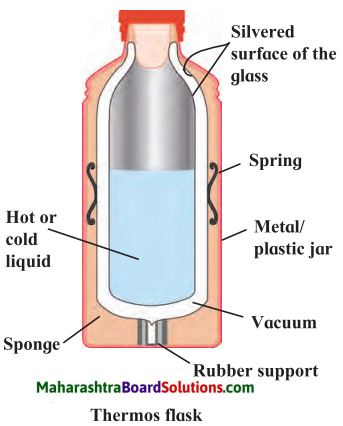
Principle:
1. As there is no medium in the vacuum between the two bottles, no transfer of heat can take place by conduction or convection.
2. Radiant heat is reflected back inside from the shiny surfaces.
3. Glass and plastic are bad conductors of heat hence they do not transfer heat either into or out of the bottle. Thus transfer of heat does not take place by any of the three modes, namely conduction, convection or radiation Hence, hot things in the flask remain hot and cold things cold.
Structure:
- A thermos flask consists of two thin glass bottles fitted one inside the other.
- The inner surfaces of the bottles have a silver coating to shine like a mirror.
- A vacuum is created in the space between the two bottles by removing all the air from it.
- A plastic or cork lid is provided to fit on the mouth of the bottle.
![]()
Draw neat labelled diagrams of:
Question 1.
The relation between density and convection
Answer:
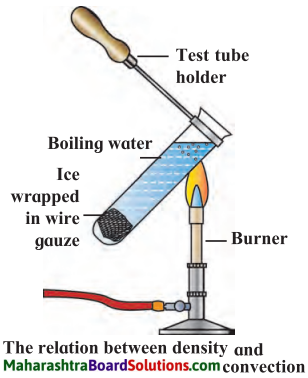
Question 2.
Conduction of heat
Answer:
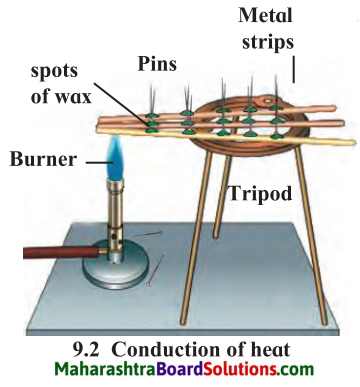
Question 3.
Convection of heat
Answer:
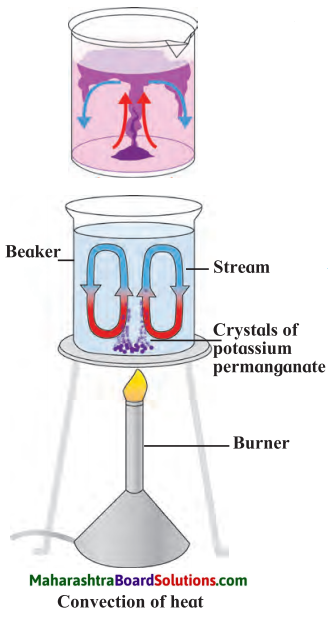
Question 4.
Expansion and contraction of a liquid
Answer:
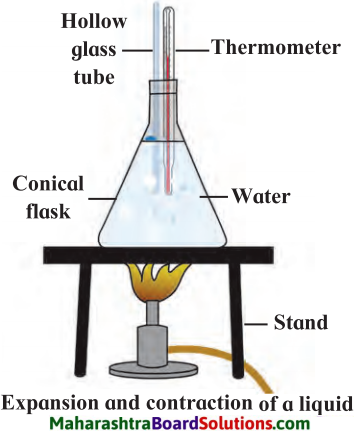
Question 5.
Thermos flask
Answer:

Can you tell?
Answer the following questions:
Question 1.
Why does the halwai wrap up cloth around the end of his slotted spoon while stirring the boiling milk in his large kadhai?
Answer:
The halwai wrap up cloth around the end of his slotted spoon while stirring the boiling milk in his large kadhai because (i) His slotted spoon is made up of metal and metal is a good conductor of heat so due to constant heating spoon gets very hot which makes hand to get burnt, (ii) But cloth is a bad conductor of heat so it does not allow heat to reach till hand and halwai does not feel hot when he stirs the boiling milk.
![]()
Question 2.
Why do we hold a steel glass in a handkerchief while drinking hot milk from it?
Answer:
- Steel is metal and it is a good conductor of heat. So due to hot milk it becomes hot and it is difficult to hold. Person’s hand get burnt due to it.
- So it is better to hold in a handkerchief because handkerchief is made up of cloth which is a bad conductor of heat. So your hand does not feel hot.
Use your brain power!
Question 1.
Why do we wear woollen clothes in winter?
Answer:
We wear woollen clothes in winter because
- Air is a poor conductor of heat and woollen clothes do not allow the transfer of body heat.
- Therefore we do not feel cold in woollen clothes and get protected from cold in winter.
Question 2.
Why do we use white clothes in summer and dark or black clothes in winter?
Answer:
- White clothes do not absorb heat, so in summer, weather is very hot and white clothes protect us from heat whereas in winter it is very cold so we need more heat.
- Dark or black clothes absorb more heat so we get protection from cold.
![]()
Question 3.
Why is there a gap at the joints of rails and of cement concrete bridges?
Answer:
- The joints of rails and cement concrete bridges are made of iron. Metal is a good conductor of heat so in summer due to heat it expands and its length will be increased.
- To allow for this expansion, gaps are kept.
- If these gaps are not kept, then after expansion the rails and cement concrete would have buckled upwards due to lack of space.
- Due to that bridges would crack and railway tracks get crooked.
Question 4.
Why is mercury or alcohol used in a thermometer?
Answer:
Mercury is used in a thermometer because of the following properties.
Alcohol is used in a thermometer for the following properties.
- It can measure a low temperature because its freezing point is low. (-115°C) but it can not measure higher temperature as its boiling point is low.
- It can measure the temperature precisely because it has large expansion coefficient.
- It’s expansion is regular.
- Less hazardous.
![]()
Question 5.
Why hot substance does not remain as hot after two or three hours?
Answer:
A little heat is lost from around the lid and by a small amount of conduction through the vessel. So hot substance does not remain as hot after two or three hours.
Diagram based questions.
Observe the diagram and answer the given questions below it.
1.

Question a.
What is the diagram about?
Answer:
The diagram is showing us the relation between density and convection.
Question b.
Why is the ice wrapped in wire gauze?
Answer:
Ice floats on water, to make it sink, it is wrapped in wire gauze.
![]()
Question c.
What does this experiment prove?
Answer:
When a liquid is heated, its density decreases and it rises upwards. This leads to the convection currents which makes the heated liquid rise upwards and cooler liquid takes it place.
2.
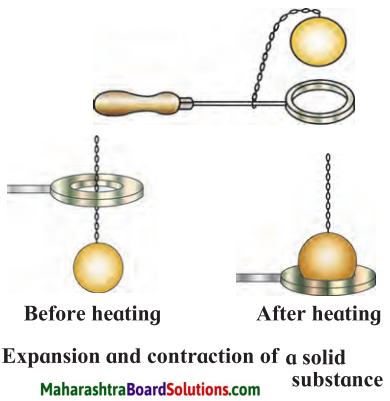
Question a.
What is the diagram about?
Answer:
Expansion and contraction of a solid substance.
Question b.
Does the same thing happen in liquids and gases?
Answer:
Yes. Generally substances solids, liquids and gases expand on heating and contract on cooling.
![]()
Question c.
Give one example of this property in everyday life.
Answer:
Gaps are present in between two railway line track joints so that they do not bend due to expansion.
3.
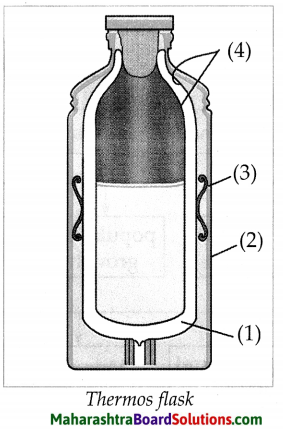
Question a.
Label parts 1 – 4
Answer:
- Vacuum
- metal/plastic jar
- Spring
- silvered surface of the glass.
Question b.
What is the principle of this object?
Answer:
As there is no medium in the vacuum between the two bottles, no transfer of heat takes place due to conduction and convection and radiated heat is reflected back by the shiny surface.
Question c.
State the uses of the given object.
Answer:
The temperature of substances inside it are maintained for some time. Hot things remain hot and cold things cold for 2 – 3 hours.
![]()
Question d.
What is an infrared camera?
Answer:
It is a camera which uses radiations to make our surroundings visible at night. Using this camera, it is possible to keep a watch on the movements of the enemy during the night.
Question e.
What is thermoware?
Answer:
Thermoware are object which do not allow heat to escape from them. So things stay warm in them. eg. hot pot, thermos flask.
7th Std Science Questions And Answers:
- The Living World: Adaptations and Classification Class 7 Questions And Answers
- Plants: Structure and Function Class 7 Questions And Answers
- Properties of Natural Resources Class 7 Questions And Answers
- Nutrition in Living Organisms Class 7 Questions And Answers
- Food Safety Class 7 Questions And Answers
- Measurement of Physical Quantities Class 7 Questions And Answers
- Motion, Force and Work Class 7 Questions And Answers
- Static Electricity Class 7 Questions And Answers
- Heat Class 7 Questions And Answers
- Disaster Management Class 7 Questions And Answers
